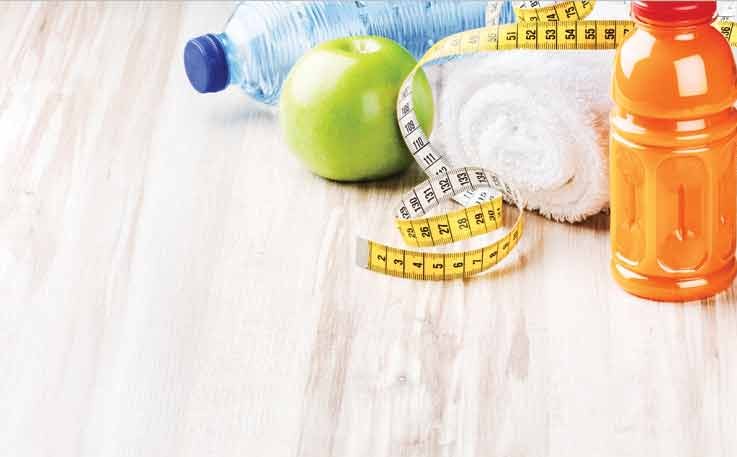“Finish your food; children are starving in Africa!” That’s the refrain boomers most likely heard when they were growing up. That’s because much of the world was, indeed, hungry. Today, we’re more likely to find people dying from overeating. Hard to believe, but the World Health Organization reports that obesity is gaining ground on undernourishment and infectious diseases as the most significant global health problems. Whether it’s overeating or voluntary under-eating, food issues have gotten complicated.
[diet debate]
What’s the best diet? The answer is easy: The one you’ll stick with! Losing weight is as simple as realizing that you can’t take in more calories.
 the big picture
the big picture
Diets that bring quick results often tell you to eat a lot of one particular thing—remember the grapefruit diet?—or to never eat another thing. For example, sugar is verboten on the South Beach Diet. “I’m not saying you can’t get results from that kind of diet. Obviously some people do,” says registered dietitian Jessica Germanese of Germanese Nutrition Counseling. “But you have to look at how that diet impacts your life and whether it is sustainable.” “Any kind of dietitian is going to encourage you to find a healthy pattern that is going to be long-standing,” echoes Samantha Strimpel, a registered dietitian at Physician Choice Wellness. “Most health professionals steer clients away from a trend or fad and encourage them to incorporate a balanced diet of whole grains, fruits, vegetables, low-fat dairy products and lean meats.
 get real
get real
The biggest diet hurdle is volume: We do not realize how enormous portion sizes have become. “Just because something is served to you in a restaurant does not mean that is what you should eat,” Germanese says. “We need to be aware that portions are often too large.” Strimpel applauds the growing practice of listing calorie counts on restaurant menus, although it remains to be seen whether that will affect consumption habits. “A good daily diet should be at an appropriate calorie level, although it doesn’t have to be a specific number every day,” she says. “Eat mindfully and pay attention to internal cues. When the stomach growls, eat. When it starts to feel full, stop.”
 no quick fixes!
no quick fixes!
The diet a bonafide nutritionist would recommend will be based on variety, health and portion control. Germanese is suspicious of plans that rule out certain foods, especially entire food groups. A likely candidate for such elimination is the carbohydrate group, which ranges from simple sugars to whole grains. “But if a diet cuts out certain food groups, the changes cannot be sustainable,” she says. “For example, you can’t live without carbohydrates.”
The healthiest foods offer the bonus of optimum enjoyment for minimum penalty, Strimpel adds. “When people eat the right foods they will be able to eat larger quantities because those foods have a lot of nutrition for a low amount of calories.”

go ahead, mangia!
A healthy day at the plate need not be boring. “My philosophy is, all foods in moderation,” Germanese says. “Pleasure is one function of food. I encourage clients to eat the foods they enjoy frequently, but in small portions. I call them ‘fun foods.’ That is not going to impact your health. What could impact your health is avoiding those foods then eating them anyway, feeling depressed and guilty and eating more anyway.” Sound familiar?
Starvation dieting also is unsustainable. “A lot of people, particularly women, will cut their calories way too low, which slows their metabolism and almost does more harm than good,” Strimpel says. “They may run 5 miles and try not to eat anything all day. That is the wrong way to do it.”
[magic metabolism]
We all know them: people who can’t seem to lose weight even though they eat a lot less than we do. Are they secretly gorging on quarts of ice cream in bed? Not necessarily. Is something wrong with their metabolisms? “That is a frequently asked question,” says Dr. Deepashree Gupta, assistant professor and endocrinologist at Saint Louis University School of Medicine. “Yes, we do inherit our metabolism.”
the root of the problem
A position statement by the American Association of Clinical Endocrinologists listed appetite dysregulation, abnormal energy balance and endocrine dysfunction among the causes of weight problems. “It is also clear that there are behavioral determinants of obesity, some of which are under the control of the individual such as wellness behavior, diet preferences and physical activity. However, obesity is also highly determined by genetic factors,” it reported. Obesity’s origins are deeper than bad habits, the statement recognized. “The conclusion that obesity is a disease represents a paradigm shift that stands in stark contrast to the notion that obesity simply results from the personal tendency to overeat or engage in a sedentary lifestyle.” “Exercise does burn calories, but it doesn’t necessarily burn a lot of calories,” says Dr. Samuel Klein, a gastroenterologist and professor at Washington University School of Medicine. “If you walk very briskly for an hour, you will burn 350 or 400 calories. If you go back home and have one slice of pizza and a beer, you already have put back those calories.” Which makes life that much harder for those predisposed to obesity. “You have to be ever-vigilant. It requires a strong behavioral intent if you are genetically predisposed to obesity.”
we’re different
“There is a strong genetic component to obesity that can be triggered by environmental factors,” notes Klein. “The contribution of genes versus environment probably varies from person to person, but they are both very important in determining who is going to be obese and who is not. It is complicated.” Genetic factors contribute 40 percent to 70 percent of one’s development of body weight, according to a paper published in the medical journal Diabetes Care in 2008. It said nearly 600 “obesity candidate genes” have been identified. The human propensity to store fat evolved over millennia of hard work with scarce food supplies, Gupta adds. “Our genes were programmed for less food intake and more physical activity. In recent times we have more food and less physical activity. Being overweight is the price we are paying for it.”
[eating disorders]
Binge eating , purging, self-imposed starvation—the ways we distort the simple process of fueling our bodies are numerous and often inexplicable. Why? It started with Twiggy.
“Our society over-emphasizes weight control and diet and having a really lean body with super muscularity,” says Dr. Kim McCallum, medical director and founder of McCallum Eating Disorder Centers. Self-conscious people, particularly young women, are exposed to feminine ideals that are unrealistically thin. “Our media and culture drive a lot of body dissatisfaction,” McCallum says. “We see digitally modified images that don’t even resemble the real models.” For someone who has a predisposition for anxiety, the fear of being fat can be a veritable can of worms, says Nancy Albus, CEO of Castlewood Treatment Centers. “And for others, food is comfort and creates a fulfillment or sense of enjoyment in a life that may be lacking those things.”
problems start early
“The average age of (anorexia) onset is 11 to 14 years,” McCallum says, when physical and social changes are swirling and the body is changing quickly. “Girls should gain about 40 pounds during this time and boys even more than that.” But eating disorder patients may view themselves as fat even when they appear thin to others. “That is body dysmorphia,” Albus says. “They look in the mirror and see themselves as double the size they really are.” Eating disorders programs have historically served young females, but that is changing, Albus says. “In the past couple of years we have seen more men seeking treatment and more women of middle age.”
why?
“There often is a genetic predisposition—50 percent of eating disorder clients suffer from depressive symptoms. Sometimes a traumatic event occurs and the disorder helps the person navigate through that period in their lives,” says Albus, a licensed professional counselor and certified eating disorder specialist. “We often hear people say there is a feeling that losing weight and transforming their appearance will solve a problem.”
Eating disorder patients often come from the top of the class. “There are some traits that may make you vulnerable, such as being perfectionistic and anxious,” McCallum says. “There are groups of athletes who are more at risk because they participate in sports that focus on body weight.”
it can be deadly
The National Eating Disorders Association (NEDA) estimates that 20 million women and 10 million men in the U.S. will suffer from eating disorders during their lifetime. “Eating disorders have one of the highest death rates among mental illnesses,” McCallum says. “The two biggest causes are cardiovascular. Folks with eating disorders also have a higher-than-expected risk for suicide.”
eating disorders may cause:
> slow heart rate
> low blood pressure
> osteoporosis
> muscle loss
> dehydration leading to kidney failure
> fatigue
> fainting
> dry skin
> hair loss
electrolyte imbalances resulting from purging can cause:
> irregular heartbeats
> heart failure
> stomach or throat injuries
> tooth decay
> Bowel disease from laxative abuse
[food facts]
Most of the global population lives in countries where being overweight kills more people than being underweight, according to the World Health Organization.
The average woman 19 to 30 needs 2,000 calories a day; women 31 to 50 need 1,800; and women 51 and older need 1,600.
which of these things is not like the others?
According to the USDA online Food-A-Pedia tracker:
Food Calories
| Scoop of vanilla ice cream | 137 |
| 12-ounce soda | 189 |
| Big Mac hamburger | 585 |
| 1 ounce of potato chips | 145 |
| Small order of fast-food fries | 271 |
| 1 slice of pizza with meat | 328 |
| 1 cup whole milk | 149 |
| 1 cup broccoli | 30 |
Extra calories add up to extra pounds. Consider one small piece of 10-calorie hard candy, says Dr. Samuel Klein. “If you eat 10 calories a day more than you burn, you will gain about a pound in three years. If you have just one candy bar a day, about 220 calories, you will gain 22 pounds in three years.”








